Antioxidant System of Scutellum During Germination and Early Growth of Maize Seedlings
Abstract
1. Introduction
2. Materials and Methods
2.1. Biological Material, Storage Conditions, and Reagents Used
2.2. Germination Conditions and Obtaining the Scutellum
2.3. Histochemical and Immunochemical Analysis
2.3.1. Fixation, Infiltration, and Cutting
2.3.2. Anatomical Staining
2.3.3. Lipid Detection
2.3.4. Starch Detection
2.3.5. Immunolocalization
2.4. Enzyme Activity Assays
2.4.1. Enzymatic Extraction
2.4.2. Quantification of Catalase Activity
2.4.3. Quantification of Superoxide Dismutase Activity
2.4.4. Quantification of Peroxidase Activity
2.5. Statistical Analysis
3. Results
3.1. Morphometry During Germination
3.2. Anatomical Changes in the Scutellum Epidermis and the Accumulation of Reserve Substances
3.3. Activity and Location of Antioxidant Enzymes in the Scutellum
3.3.1. Catalase Activity
3.3.2. Location of the Catalase
3.3.3. Superoxide Dismutase Activity
3.3.4. Location of Superoxide Dismutase
3.3.5. Class III Peroxidase Activity
3.3.6. Location of Class III Peroxidase
3.4. Comparison of CAT and POX Activities
4. Discussion
4.1. Functional Relevance of the Scutellum
4.2. Relationships Between Metabolism with the Activity and Location of Antioxidant Enzymes
5. Conclusions
Author Contributions
Funding
Institutional Review Board Statement
Data Availability Statement
Conflicts of Interest
References
- Colin, W. Chapter 2—The Cereal Grains: Providing Our Food, Feed and Fuel Needs. In Cereal Grains, 2nd ed.; Wrigley, C., Batey, I., Miskelly, D., Eds.; Woodhead Publishing Series in Food Science, Technology and Nutrition; Woodhead Publishing: Sawston, UK, 2017; pp. 27–40. ISBN 9780081007198. Available online: https://www.sciencedirect.com/science/article/pii/B9780081007198000024 (accessed on 25 October 2024). [CrossRef]
- Ranum, P.; Peña-Rosas, J.P.; Garcia-Casal, M.N. Global Maize Production, Utilization, and Consumption. Ann. N. Y. Acad. Sci. 2014, 1312, 105–112. [Google Scholar] [CrossRef]
- Anderson, B.; Almeida, H. Corn Dry Milling: Processes, Products, and Applications. In Corn; Serna-Saldivar, S.O., Ed.; Elsevier: Amsterdam, The Netherlands, 2019; pp. 405–433. [Google Scholar] [CrossRef]
- BeMiller, J.N. Corn Starch Modification. In Corn; Serna-Saldivar, S.O., Ed.; Elsevier: Amsterdam, The Netherlands, 2019; pp. 537–549. [Google Scholar] [CrossRef]
- Helstad, S. Corn Sweeteners. In Corn; Serna-Saldivar, S.O., Ed.; Elsevier: Amsterdam, The Netherlands, 2019; pp. 551–591. [Google Scholar] [CrossRef]
- Kumar, D.; Singh, V. Bioethanol Production from Corn. In Corn; Serna-Saldivar, S.O., Ed.; Elsevier: Amsterdam, The Netherlands, 2019; pp. 615–631. [Google Scholar] [CrossRef]
- Loy, D.D.; Lundy, E.L. Nutritional Properties and Feeding Value of Corn and Its Coproducts. In Corn; Serna-Saldivar, S.O., Ed.; Elsevier: Amsterdam, The Netherlands, 2019; pp. 633–659. [Google Scholar] [CrossRef]
- Palacios-Rojas, N.; McCulley, L.; Kaeppler, M.; Titcomb, T.J.; Gunaratna, N.S.; Lopez-Ridaura, S.; Tanumihardjo, S.A. Mining Maize Diversity and Improving Its Nutritional Aspects within Agro-food Systems. Compr. Rev. Food Sci. Food Saf. 2020, 19, 1809–1834. [Google Scholar] [CrossRef]
- Serna-Saldivar, S.O.; Chuck-Hernandez, C. Food Uses of Lime-Cooked Corn with Emphasis in Tortillas and Snacks. In Corn; Serna-Saldivar, S.O., Ed.; Elsevier: Amsterdam, The Netherlands, 2019; pp. 469–500. [Google Scholar] [CrossRef]
- FAO. FAOSTAT. 2024. Available online: https://www.fao.org/faostat/en/#home (accessed on 5 October 2024).
- CONABIO. CONABIO, 25 Años de Evolución. 2017. Available online: https://www.gob.mx/cms/uploads/attachment/file/262393/25_an_os_Conabio_web.pdf (accessed on 11 October 2024).
- Arteaga, M.C.; Moreno-Letelier, A.; Mastretta-Yanes, A.; Vázquez-Lobo, A.; Breña-Ochoa, A.; Moreno-Estrada, A.; Eguiarte, L.E.; Piñero, D. Genomic Variation in Recently Collected Maize Landraces from Mexico. Genom. Data 2016, 7, 38–45. [Google Scholar] [CrossRef]
- Herrera-Cabrera, B.E.; Castillo-González, F.; Sánchez-González, J.J.; Hernández-Casillas, J.M.; Ortega-Pazkca, R.A.; Major-Goodman, M. Diversidad Del Maíz Chalqueño. Agrociencia 2004, 38, 191–206. [Google Scholar]
- Goodman, M.M.; Sanchez, G.J.J.; Stuber, C.W. Isozymatic and Morphological Diversity in the Races of Maize of Mexico. Econ. Bot. 2000, 54, 43–59. [Google Scholar] [CrossRef]
- Sánchez, G.J.J.; Stuber, C.W.; Goodman, M.M. Isozymatic Diversity of the Races of Maize of the Americas. Maydica 2000, 45, 185–203. [Google Scholar]
- Kuleshov, N.N. Maíces de México, Guatemala, Cuba, Panamá, y Colombia. In Las Plantas Cultivadas de México, Guatemala y Colombia; Bukasov, S.M., Ed.; CATIE: Turrialba, Costa Rica, 1981; pp. 40–53. [Google Scholar]
- CONABIO. Proyecto Global de maíces Nativos: Recopilación, Generación, Actualización y análisis de Información Acerca de la Diversidad Genética de Maíces y sus Parientes Silvestres en México. 2011. Available online: https://www.biodiversidad.gob.mx/media/1/genes/files/InformedeGestion_V1.pdf (accessed on 11 October 2024).
- Kato Yamakake, T.A.; Mapes Sánchez, C.; Mera Ovando, L.M.; Serratos Hernández, J.A.; Bye Boettler, R.A. Origen y Diversificaión del Maíz: Una Revisión Analìtica; Universidad Nacional Autónoma de México: México, Mexico, 2009. [Google Scholar]
- Wellhausen, E.J.; Roberts, L.M. Razas de Maíz En México: Su Origen, Características y Distribución; Oficina de Estudios Especiales, Secretaría de Agricultura y Ganadería de México: México, Mexico, 1951. [Google Scholar]
- Biodiversidad Mexicana. Visualización Interactiva: Diversidad y Distribución de Maíces. Proyecto Global de Maíces. 2023. Available online: https://conabio.shinyapps.io/conabio-pgmaices1/ (accessed on 11 October 2024).
- CONABIO. Proyecto Global de Maíces Nativos. Tabla Descriptiva de Razas de Maíz en México. 2010. Available online: https://www.biodiversidad.gob.mx/media/1/genes/files/Tabla_razas_marzo_2010.pdf (accessed on 10 October 2024).
- Antonio-Miguel, M.; Arellano-Vázquez, J.L.; García-de Los Santos, G.; Miranda-Colín, S.; Mejía-Contreras, J.A.; González-Cossío, F.V. Variedades Criollas De Maíz Azul Raza Chalqueño. Características Agronómicas y Calidad De Semilla. Rev. Fitotec. Mex. 2022, 27, 9–15. [Google Scholar] [CrossRef]
- Hernández, C.J.M. Proyecto FZ016 “Conocimiento de la Diversidad y Distribución Actual del Maíz Nativo y sus Parientes Silvestres en México. Segunda Etapa 2008–2009”; Informe Final del Estado de México y D. F. INIFAP, Campo Experimental Valle de México; INIFAP: Hidalgo, México, 2010; 17p. [Google Scholar]
- Hernández, C.J.M.; Díaz de la C, J.B.; Base de Datos de Colecciones de Maíces Nativos, Teocintle y Tripsacum de México. Informe Final de Actividades 2007–2010. Convenio Núm.FB1261/FY001/07 CONABIO/INIFAP. México, D.F. Informe final del Proyecto FY001 Base de Datos de Colecciones de Maíces Nativos, Teocintles y Tripsacum de México. Available online: http://www.conabio.gob.mx/institucion/proyectos/resultados/InfFY001.pdf (accessed on 14 October 2024).
- Rocandio-Rodríguez, M.; Santacruz-Varela, A.; Córdova-Téllez, L.; López-Sánchez, H.; Castillo-González, F.; Lobato-Ortiz, R.; García-Zavala, J.J.; Ortega-Paczka, R. Caracterización morfológica y agronómica de siete razas de maíz de los Valles Altos de México. Rev. Fitotec. Mex. 2014, 37, 351–361. [Google Scholar] [CrossRef]
- Dourmap, C.; Roque, S.; Morin, A.; Caubrière, D.; Kerdiles, M.; Béguin, K.; Perdoux, R.; Reynoud, N.; Bourdet, L.; Audebert, P.-A.; et al. Stress Signalling Dynamics of the Mitochondrial Electron Transport Chain and Oxidative Phosphorylation System in Higher Plants. Ann. Bot. 2020, 125, 721–736. [Google Scholar] [CrossRef]
- Sánchez-Linares, L.; Gavilanes-Ruíz, M.; Díaz-Pontones, D.; Guzmán-Chávez, F.; Calzada-Alejo, V.; Zurita-Villegas, V.; Luna-Loaiza, V.; Moreno-Sánchez, R.; Bernal-Lugo, I.; Sánchez-Nieto, S. Early Carbon Mobilization and Radicle Protrusion in Maize Germination. J. Exp. Bot. 2012, 63, 4513–4526. [Google Scholar] [CrossRef]
- Ali, A.S.; Elozeiri, A.A. Metabolic Processes During Seed Germination. In Advances in Seed Biology; Jimenez-Lopez, J.C., Ed.; IntechOpen: London, UK, 2017. [Google Scholar] [CrossRef]
- Andrade, G.C.D.; Coelho, C.M.M.; Padilha, M.S. Seed Reserves Reduction Rate and Reserves Mobilization to the Seedling Explain the Vigour of Maize Seeds. J. Seed Sci. 2019, 41, 488–497. [Google Scholar] [CrossRef]
- Cao, H.; Duncan, O.; Millar, A.H. The Molecular Basis of Cereal Grain Proteostasis. Essays Biochem. 2022, 66, 243–253. [Google Scholar] [CrossRef]
- Makhaye, G.; Mofokeng, M.M.; Tesfay, S.; Aremu, A.O.; Van Staden, J.; Amoo, S.O. Influence of Plant Biostimulant Application on Seed Germination. In Biostimulants for Crops from Seed Germination to Plant Development; Gupta, S., Van Staden, J., Eds.; Elsevier: Amsterdam, The Netherlands, 2021; pp. 109–135. [Google Scholar] [CrossRef]
- Tnani, H. The Structure and Function of Maize Scutellum during Early Stages of Germination. Doctoral Thesis, Universitat de Barcelona, Barcelona, Spain, 2012. Available online: https://diposit.ub.edu/dspace/handle/2445/36321 (accessed on 17 July 2024).
- Mittler, R. ROS Are Good. Trends Plant Sci. 2017, 22, 11–19. [Google Scholar] [CrossRef]
- Farooq, M.A.; Zhang, X.; Zafar, M.M.; Ma, W.; Zhao, J. Roles of Reactive Oxygen Species and Mitochondria in Seed Germination. Front. Plant Sci. 2021, 12, 781734. [Google Scholar] [CrossRef]
- Møller, I.M.; Jensen, P.E.; Hansson, A. Oxidative Modifications to Cellular Components in Plants. Annu. Rev. Plant Biol. 2007, 58, 459–481. [Google Scholar] [CrossRef]
- Akter, S.; Khan, M.S.; Smith, E.N.; Flashman, E. Measuring ROS and Redox Markers in Plant Cells. RSC Chem. Biol. 2021, 2, 1384–1401. [Google Scholar] [CrossRef]
- Mhamdi, A.; Van Breusegem, F. Reactive Oxygen Species in Plant Development. Development 2018, 145, dev164376. [Google Scholar] [CrossRef]
- Waszczak, C.; Carmody, M.; Kangasjärvi, J. Reactive Oxygen Species in Plant Signaling. Annu. Rev. Plant Biol. 2018, 69, 209–236. [Google Scholar] [CrossRef]
- Bailly, C.; El-Maarouf-Bouteau, H.; Corbineau, F. From Intracellular Signaling Networks to Cell Death: The Dual Role of Reactive Oxygen Species in Seed Physiology. Comptes Rendus. Biol. 2008, 331, 806–814. [Google Scholar] [CrossRef]
- Kurek, K.; Plitta-Michalak, B.; Ratajczak, E. Reactive Oxygen Species as Potential Drivers of the Seed Aging Process. Plants 2019, 8, 174. [Google Scholar] [CrossRef]
- Li, W.; Niu, Y.; Zheng, Y.; Wang, Z. Advances in the Understanding of Reactive Oxygen Species-Dependent Regulation on Seed Dormancy, Germination, and Deterioration in Crops. Front. Plant Sci. 2022, 13, 826809. [Google Scholar] [CrossRef]
- Huang, H.; Ullah, F.; Zhou, D.-X.; Yi, M.; Zhao, Y. Mechanisms of ROS Regulation of Plant Development and Stress Responses. Front. Plant Sci. 2019, 10, 800. [Google Scholar] [CrossRef]
- Priestley, D.A. Seed Aging: Implications for Seed Storage and Persistence in the Soil; Cornell University Press: Ithaca, NY, USA, 1986. [Google Scholar]
- Bailly, C.; Benamar, A.; Corbineau, F.; Côme, D. Changes in Superoxide Dismutase, Catalase and Glutathione Reductase Activities in Sunflower Seeds during Accelerated Ageing and Subsequent Priming. In Basic and Applied Aspects of Seed Biology; Ellis, R.H., Black, M., Murdoch, A.J., Hong, T.D., Eds.; Springer: Dordrecht, The Netherlands, 1997; Volume 30, pp. 665–672. [Google Scholar] [CrossRef]
- Bailly, C.; Audigier, C.; Ladonne, F.; Wagner, M.H.; Coste, F.; Corbineau, F.; Côme, D. Changes in Oligosaccharide Content and Antioxidant Enzyme Activities in Developing Bean Seeds as Related to Acquisition of Drying Tolerance and Seed Quality. J. Exp. Bot. 2001, 52, 701–708. [Google Scholar] [CrossRef]
- Dučić, T.; Lirić-Rajlić, I.; Mitrović, A.; Radotić, K. Activities of Antioxidant Systems During Germination of Chenopodium Rubrum Seeds. Biol. Plant 2003, 46, 527–533. [Google Scholar] [CrossRef]
- Blokhina, O. Antioxidants, Oxidative Damage and Oxygen Deprivation Stress: A Review. Ann. Bot. 2003, 91, 179–194. [Google Scholar] [CrossRef]
- Devi, S.R.; Prasad, M.N.V. Antioxidant Capacity of Brassica Juncea Plants Exposed to Elevated Levels of Copper. Russ. J. Plant Physiol. 2005, 52, 205–208. [Google Scholar] [CrossRef]
- Scandalios, J.G. Oxygen Stress and Superoxide Dismutases. Plant Physiol. 1993, 101, 7–12. [Google Scholar] [CrossRef]
- Liszkay, A.; Kenk, B.; Schopfer, P. Evidence for the Involvement of Cell Wall Peroxidase in the Generation of Hydroxyl Radicals Mediating Extension Growth. Planta 2003, 217, 658–667. [Google Scholar] [CrossRef]
- Corona-Carrillo, J.I.; Flores-Ponce, M.; Chávez-Nájera, G.; Díaz-Pontones, D.M. Peroxidase Activity in Scutella of Maize in Association with Anatomical Changes during Germination and Grain Storage. SpringerPlus 2014, 3, 399. [Google Scholar] [CrossRef][Green Version]
- Negbi, M. The Structure and Function of the Scutellum of the Gramineae. Bot. J. Linn. Soc. 1984, 88, 205–222. [Google Scholar] [CrossRef]
- Domínguez, F.; Moreno, J.; Cejudo, F.J. The Scutellum of Germinated Wheat Grains Undergoes Programmed Cell Death: Identification of an Acidic Nuclease Involved in Nucleus Dismantling. J. Exp. Bot. 2012, 63, 5475–5485. [Google Scholar] [CrossRef][Green Version]
- Bewley, J.D. Seed Germination and Reserve Mobilization. In Encyclopedia of Life Sciences; Wiley: Hoboken, NJ, USA, 2001. [Google Scholar] [CrossRef]
- Bewley, J.D.; Bradford, K.J.; Hilhorst, H.W.M.; Nonogaki, H. Seeds: Physiology of Development, Germination and Dormancy, 3rd ed.; Springer: New York, NY, USA, 2013. [Google Scholar] [CrossRef]
- Miyata, S.; Okamoto, K.; Watanabe, A.; Akazawa, T. Enzymic Mechanism of Starch Breakdown in Germinating Rice Seeds: 10. In Vivo And In Vitro Synthesis Of A-Amylase in Rice Seed Scutellum. Plant Physiol. 1981, 68, 1314–1318. [Google Scholar] [CrossRef]
- Okamoto, K.; Kitano, H.; Akazawa, T. Biosynthesis and Excretion of Hydrolases in Germinating Cereal Seeds. Plant Cell Physiol. 1980, 21, 201–204. [Google Scholar] [CrossRef]
- Sopanen, T.; Burston, D.; Matthews, D.M. Uptake of Small Peptides by the Scutellum of Germinating Barley. FEBS Lett. 1977, 79, 4–7. [Google Scholar] [CrossRef][Green Version]
- Sopanen, T.; Burston, D.; Taylor, E.; Matthews, D.M. Uptake of Glycylglycine by the Scutellum of Germinating Barley Grain. Plant Physiol. 1978, 61, 630–633. [Google Scholar] [CrossRef]
- Salmenkallio, M.; Sopanen, T. Amino Acid and Peptide Uptake in the Scutella of Germinating Grains of Barley, Wheat, Rice, and Maize. Plant Physiol. 1989, 89, 1285–1291. [Google Scholar] [CrossRef]
- West, C.E.; Waterworth, W.M.; Stephens, S.M.; Smith, C.P.; Bray, C.M. Cloning and Functional Characterisation of a Peptide Transporter Expressed in the Scutellum of Barley Grain during the Early Stages of Germination. Plant J. 1998, 15, 221–229. [Google Scholar] [CrossRef]
- Feng, J.-H.; Xu, X.-B.; Liu, X.-D.; Zhang, C.-L.; Liang, X.-L.; Wu, W.-C. Embryogenesis, Germination, Structure and Cotyledon Dimorphism of Zea mays Embryo. J. Integr. Plant Biol. 2003, 45, 712–723. [Google Scholar]
- Tnani, H.; López, I.; Vicient, C.M. Control of the Scutellar Epithelial Cell Elongation during Germination in Maize (Zea mays L.). Seed Sci. Technol. 2011, 39, 253–258. [Google Scholar] [CrossRef]
- Tnani, H.; López-Ribera, I.; García-Muniz, N.; Vicient, C.M. ZmPTR1, a Maize Peptide Transporter Expressed in the Epithelial Cells of the Scutellum during Germination. Plant Sci. 2013, 207, 140–147. [Google Scholar] [CrossRef]
- Stewart, C.R. Some Characteristics of the Uptake of Glutamine by Corn Scutellum. Plant Physiol. 1971, 47, 157–161. [Google Scholar] [CrossRef]
- Subbarao, K.V.; Datta, R.; Sharma, R. Amylases Synthesis in Scutellum and Aleurone Layer of Maize Seeds. Phytochemistry 1998, 49, 657–666. [Google Scholar] [CrossRef]
- Dure, L.S. Gross Nutritional Contributions of Maize Endosperm and Scutellum to Germination Growth of Maize Axis. Plant Physiol. 1960, 35, 919–925. [Google Scholar] [CrossRef]
- Enríquez-Arredondo, C.; Sánchez-Nieto, S.; Rendón-Huerta, E.; González-Halphen, D.; Gavilanes-Ruíz, M.; Díaz-Pontones, D. The Plasma Membrane H+-ATPase of Maize Embryos Localizes in Regions That Are Critical during the Onset of Germination. Plant Sci. 2005, 169, 11–19. [Google Scholar] [CrossRef]
- Ruzin, S.E. Plant Microtechnique and Microscopy; Oxford University Press: New York, NY, USA, 1999. [Google Scholar]
- Osborn, M.; Brandfass, S. Immunocytochemistry of Frozen and Paraffin Tissue Sections. In Cell Biology: A Laboratory Handbook; Academic Press: New York, NY, USA, 1994; pp. 361–367. [Google Scholar]
- DeWitt, N.D.; Sussman, M.R. Immunocytological Localization of an Epitope-Tagged Plasma Membrane Proton Pump (H(+)-ATPase) in Phloem Companion Cells. Plant Cell 1995, 7, 2053–2067. [Google Scholar] [CrossRef]
- Krishnamurthy, K.V. Methods in Plant Histochemistry; S Viswanathan Printers & Publishers: Madras, India, 1988. [Google Scholar]
- Pearse, A.G.E. Histochemistry: Theoretical and Applied; Churchill Livingstone: London, UK, 1968. [Google Scholar]
- Brown, R.C.; Lemmon, B.E. Chapter 7 Methods in Plant Immunolight Microscopy. In Methods in Cell Biology; Elsevier: Amsterdam, The Netherlands, 1995; Volume 49, pp. 85–107. [Google Scholar] [CrossRef]
- Ingvardsen, C.; Veierskov, B.; Joshi, P.A. Immunohistochemical Localisation of Ubiquitin and the Proteasome in Sunflower (Helianthus annuus Cv. Giganteus). Planta 2001, 213, 333–341. [Google Scholar] [CrossRef]
- Liszkay, A.; Van Der Zalm, E.; Schopfer, P. Production of Reactive Oxygen Intermediates (O2−, H2O2, and ˙OH) by Maize Roots and Their Role in Wall Loosening and Elongation Growth. Plant Physiol. 2004, 136, 3114–3123. [Google Scholar] [CrossRef]
- García-Lara, S.; Arnason, J.T.; Díaz-Pontones, D.; Gonzalez, E.; Bergvinson, D.J. Soluble Peroxidase Activity in Maize Endosperm Associated with Maize Weevil Resistance. Crop Sci. 2007, 47, 1125–1130. [Google Scholar] [CrossRef]
- Lowry, O.H.; Rosebrough, N.J.; Farr, A.L.; Randall, R.J. Protein Measurement with The Folin Phenol Reagent. J. Biol. Chem. 1951, 193, 265–275. [Google Scholar] [CrossRef]
- Bailly, C.; Kranner, I. Analyses of Reactive Oxygen Species and Antioxidants in Relation to Seed Longevity and Germination. In Seed Dormancy; Kermode, A.R., Ed.; Humana Press: Totowa, NJ, USA, 2011; Volume 773, pp. 343–367. [Google Scholar] [CrossRef]
- Aebi, H. Catalase in Vitro. In Methods in Enzymology; Packer, L., Ed.; Elsevier: Amsterdam, The Netherlands, 1984; Volume 105, pp. 121–126. [Google Scholar] [CrossRef]
- Chandlee, J.M.; Tsaftaris, A.S.; Scandalios, J.G. Purification and Partial Characterization of Three Genetically Defined Catalases of Maize. Plant Sci. Lett. 1983, 29, 117–131. [Google Scholar] [CrossRef]
- Bolwell, G.P.; Davies, D.R.; Gerrish, C.; Auh, C.-K.; Murphy, T.M. Comparative Biochemistry of the Oxidative Burst Produced by Rose and French Bean Cells Reveals Two Distinct Mechanisms1. Plant Physiol. 1998, 116, 1379–1385. [Google Scholar] [CrossRef]
- Haddad, N.I.A.; Yuan, Q. Purification and Some Properties of Cu, Zn Superoxide Dismutase from Radix Lethospermi Seed, Kind of Chinese Traditional Medicine. J. Chromatogr. B 2005, 818, 123–131. [Google Scholar] [CrossRef]
- Maehly, A.C.; Chance, B. The Assay of Catalases and Peroxidases. In Methods of Biochemical Analysis; Glick, D., Ed.; Wiley: Hoboken, NJ, USA, 1954; Volume 1, pp. 357–424. [Google Scholar] [CrossRef]
- Dawson, R.M.C.; Elliott, D.C.; Dawson, R.M.C. Data for Biochemical Research, 3rd ed.; Clarendon Press: Oxford, UK, 1985; p. 352. [Google Scholar]
- Dragicevic, V.; Kovacevic, D.; Sredojevic, S.; Dumanovic, Z.; Mladenovic-Drinic, S. The Variation of Phytic and Inorganic Phosphorus in Leaves and Grain in Maize Populations. Genetika 2010, 42, 555–563. [Google Scholar] [CrossRef]
- Glass, R.L.; Geddes, W.F. Grain Storage Studies. XXVII. The Inorganic Phosphorus Content of Deteriorating Wheat. Cereal Chem. 1959, 36, 186–190. [Google Scholar]
- Raboy, V. Approaches and Challenges to Engineering Seed Phytate and Total Phosphorus. Plant Sci. 2009, 177, 281–296. [Google Scholar] [CrossRef]
- Lin, Y.-H.; Wimer, L.T.; Huang, A.H.C. Lipase in the Lipid Bodies of Corn Scutella during Seedling Growth. Plant Physiol. 1983, 73, 460–463. [Google Scholar] [CrossRef]
- Qu, R.; Wang, S.M.; Lin, Y.H.; Vance, V.B.; Huang, A.H. Characteristics and Biosynthesis of Membrane Proteins of Lipid Bodies in the Scutella of Maize (Zea mays L.). Biochem. J. 1986, 235, 57–65. [Google Scholar] [CrossRef]
- Lombi, E.; Smith, E.; Hansen, T.H.; Paterson, D.; De Jonge, M.D.; Howard, D.L.; Persson, D.P.; Husted, S.; Ryan, C.; Schjoerring, J.K. Megapixel Imaging of (Micro)Nutrients in Mature Barley Grains. J. Exp. Bot. 2011, 62, 273–282. [Google Scholar] [CrossRef]
- Lu, L.; Tian, S.; Liao, H.; Zhang, J.; Yang, X.; Labavitch, J.M.; Chen, W. Analysis of Metal Element Distributions in Rice (Oryza sativa L.) Seeds and Relocation during Germination Based on X-Ray Fluorescence Imaging of Zn, Fe, K, Ca, and Mn. PLoS ONE 2013, 8, e57360. [Google Scholar] [CrossRef] [PubMed]
- Macleod, A.M.; Palmer, G.H. Gibberellin from Barley Embryos. Nature 1967, 216, 1342–1343. [Google Scholar] [CrossRef]
- Radley, M. Production of Gibberellin-like Substances in Barley Seed and Seedlings. In Plant Growth Regulators; S.C.I. Monographs: London, UK, 1968; Volume 31, pp. 53–69. [Google Scholar]
- Stoddart, J.L.; Thomas, H.; Robertson, A. Protein Synthesis Patterns in Barley Embryos during Germination. Planta 1973, 112, 309–321. [Google Scholar] [CrossRef] [PubMed]
- Aoki, N.; Scofield, G.N.; Wang, X.-D.; Offler, C.E.; Patrick, J.W.; Furbank, R.T. Pathway of Sugar Transport in Germinating Wheat Seeds. Plant Physiol. 2006, 141, 1255–1263. [Google Scholar] [CrossRef] [PubMed]
- Doll, N.M.; Ingram, G.C. Embryo–Endosperm Interactions. Annu. Rev. Plant Biol. 2022, 73, 293–321. [Google Scholar] [CrossRef] [PubMed]
- Fincher, G.B. Molecular and Cellular Biology Associated with Endosperm Mobilization in Germinating Cereal Grains. Annu. Rev. Plant Physiol. Plant Mol. Biol. 1989, 40, 305–335. [Google Scholar] [CrossRef]
- Gibbons, G.C. On the Localisation and Transport of α-Amylase during Germination and Early Seedling Growth of Hordeum Vulgare. Carlsberg Res. Commun. 1979, 44, 353–366. [Google Scholar] [CrossRef]
- Gibbons, G.C. Immunohistochemical Determination of The Transport Pathways Of A-Amylase in Germinating Barley Seeds. Cereal Res. Commun. 1980, 8, 87–96. [Google Scholar]
- Gibbons, G.C. On the Sequential Determination of α-Amylase Transport and Cell Wall Breakdown in Germinating Seeds of Hordeum Vulgare. Carlsberg Res. Commun. 1980, 45, 177–184. [Google Scholar] [CrossRef]
- Gibbons, G.C. On the Relative Role of the Scutellum and Aleurone in the Production of Hydrolases during Germination of Barley. Carlsberg Res. Commun. 1981, 46, 215–225. [Google Scholar] [CrossRef]
- MacGregor, A.W.; Dushnicky, L. Starch Degradation in Endosperms of Developing Barley Kernels*. J. Inst. Brew. 1989, 95, 321–325. [Google Scholar] [CrossRef]
- Okamoto, K.; Akazawa, T. Enzymic Mechanisms of Starch Breakdown in Germinating Rice Seeds: 7. Amylase Formation in the Epithelium. Plant Physiol. 1979, 63, 336–340. [Google Scholar] [CrossRef]
- Palmer, G.H. The Morphology and Physiology of Malting Barley. In Cereals for Food and Beverages; Inglett, G.E., Munck, L., Eds.; Academic Press: New York, NY, USA, 1980. [Google Scholar]
- Ritchie, S.; Swanson, S.J.; Gilroy, S. Physiology of the Aleurone Layer and Starchy Endosperm during Grain Development and Early Seedling Growth: New Insights from Cell and Molecular Biology. Seed Sci. Res. 2000, 10, 193–212. [Google Scholar] [CrossRef]
- Bewley, J.D.; Black, M. Physiology and Biochemistry of Seeds in Relation to Germination; Springer: Berlin/Heidelberg, Germany, 1978. [Google Scholar] [CrossRef]
- MacNeill, G.J.; Mehrpouyan, S.; Minow, M.A.A.; Patterson, J.A.; Tetlow, I.J.; Emes, M.J. Starch as a Source, Starch as a Sink: The Bifunctional Role of Starch in Carbon Allocation. J. Exp. Bot. 2017, 68, 4433–4453. [Google Scholar] [CrossRef] [PubMed]
- Tan-Wilson, A.L.; Wilson, K.A. Mobilization of Seed Protein Reserves. Physiol. Plant 2012, 145, 140–153. [Google Scholar] [CrossRef]
- Chang, C.W. Study of Phytase and Fluoride Effects in Germinating Corn Seeds. Cereal Chem. 1967, 44, 129–142. [Google Scholar]
- Toole, E.H. The Transformations and Course of Development of Germinating Maize. Am. J. Bot. 1924, 11, 325–350. [Google Scholar] [CrossRef]
- Bailly, C. Active Oxygen Species and Antioxidants in Seed Biology. Seed Sci. Res. 2004, 14, 93–107. [Google Scholar] [CrossRef]
- Puntarulo, S.; Galleano, M.; Sanchez, R.A.; Boveris, A. Superoxide Anion and Hydrogen Peroxide Metabolism in Soybean Embryonic Axes during Germination. Biochim. Biophys. Acta 1991, 1074, 277–283. [Google Scholar] [CrossRef]
- Bykova, N.V.; Hu, J.; Ma, Z.; Igamberdiev, A.U. The Role of Reactive Oxygen and Nitrogen Species in Bioenergetics, Metabolism, and Signaling During Seed Germination. In Reactive Oxygen and Nitrogen Species Signaling and Communication in Plants; Gupta, K.J., Igamberdiev, A.U., Eds.; Springer International Publishing: Cham, Switzerland, 2015; Volume 23, pp. 177–195. [Google Scholar] [CrossRef]
- Schopfer, P. Hydroxyl Radical-induced Cell-wall Loosening in Vitro and in Vivo: Implications for the Control of Elongation Growth. Plant J. 2001, 28, 679–688. [Google Scholar] [CrossRef]
- Müller, K.; Linkies, A.; Vreeburg, R.A.M.; Fry, S.C.; Krieger-Liszkay, A.; Leubner-Metzger, G. In Vivo Cell Wall Loosening by Hydroxyl Radicals during Cress Seed Germination and Elongation Growth. Plant Physiol. 2009, 150, 1855–1865. [Google Scholar] [CrossRef]
- Caro, A.; Puntarulo, S. Nitric Oxide Generation by Soybean Embryonic Axes. Possible Effect on Mitochondrial Function. Free Radic. Res. 1999, 31 (Suppl. S1), 205–212. [Google Scholar] [CrossRef]
- Puglia, G.D. Reactive Oxygen and Nitrogen Species (RONS) Signalling in Seed Dormancy Release, Perception of Environmental Cues, and Heat Stress Response. Plant Growth Regul. 2024, 103, 9–32. [Google Scholar] [CrossRef]
- Hite, D.R.C.; Auh, C.; Scandalios, J.G. Catalase Activity and Hydrogen Peroxide Levels Are Inversely Correlated in Maize Scutella during Seed Germination. Redox Rep. 1999, 4, 29–34. [Google Scholar] [CrossRef] [PubMed]
- De Gara, L.; De Pinto, M.C.; Arrigoni, O. Ascorbate Synthesis and Ascorbate Peroxidase Activity during the Early Stage of Wheat Germination. Physiol. Plant 1997, 100, 894–900. [Google Scholar] [CrossRef]
- Tommasi, F.; Paciolla, C.; de Pinto, M.C.; De Gara, L. A Comparative Study of Glutathione and Ascorbate Metabolism during Germination of Pinus pinea L. Seeds. J. Exp. Bot. 2001, 52, 1647–1654. [Google Scholar] [CrossRef] [PubMed]
- Bazin, J.; Langlade, N.; Vincourt, P.; Arribat, S.; Balzergue, S.; El-Maarouf-Bouteau, H.; Bailly, C. Targeted mRNA Oxidation Regulates Sunflower Seed Dormancy Alleviation during Dry After-Ripening. Plant Cell 2011, 23, 2196–2208. [Google Scholar] [CrossRef]
- Basbouss-Serhal, I.; Leymarie, J.; Bailly, C. Fluctuation of Arabidopsis Seed Dormancy with Relative Humidity and Temperature during Dry Storage. J. Exp. Bot. 2016, 67, 119–130. [Google Scholar] [CrossRef]
- Kibinza, S.; Vinel, D.; Côme, D.; Bailly, C.; Corbineau, F. Sunflower Seed Deterioration as Related to Moisture Content during Ageing, Energy Metabolism and Active Oxygen Species Scavenging. Physiol. Plant 2006, 128, 496–506. [Google Scholar] [CrossRef]
- Mhamdi, A.; Noctor, G.; Baker, A. Plant Catalases: Peroxisomal Redox Guardians. Arch. Biochem. Biophys. 2012, 525, 181–194. [Google Scholar] [CrossRef]
- Pan, R.; Liu, J.; Wang, S.; Hu, J. Peroxisomes: Versatile Organelles with Diverse Roles in Plants. New Phytol. 2020, 225, 1410–1427. [Google Scholar] [CrossRef]
- Pinfield-Wells, H.; Rylott, E.L.; Gilday, A.D.; Graham, S.; Job, K.; Larson, T.R.; Graham, I.A. Sucrose Rescues Seedling Establishment but Not Germination of Arabidopsis Mutants Disrupted in Peroxisomal Fatty Acid Catabolism. Plant J. 2005, 43, 861–872. [Google Scholar] [CrossRef]
- Graham, I.A. Seed Storage Oil Mobilization. Annu. Rev. Plant Biol. 2008, 59, 115–142. [Google Scholar] [CrossRef] [PubMed]
- Scandalios, J.G. Control of Gene Expression and Enzyme Differentiation. In Physiological Genetics; Scandalios, J.G., Ed.; Elsevier: Amsterdam, The Netherlands, 1979; pp. 63–107. [Google Scholar] [CrossRef]
- Chiu, K.Y.; Chen, C.L.; Sung, J.M. Effect of Priming Temperature on Storability of Primed Sh-2 Sweet Corn Seed. Crop Sci. 2002, 42, 1996–2003. [Google Scholar] [CrossRef]
- Gallardo, K.; Job, C.; Groot, S.P.C.; Puype, M.; Demol, H.; Vandekerckhove, J.; Job, D. Proteomic Analysis of Arabidopsis Seed Germination and Priming. Plant Physiol. 2001, 126, 835–848. [Google Scholar] [CrossRef] [PubMed]
- Posmyk, M.M.; Corbineau, F.; Vinel, D.; Bailly, C.; Côme, D. Osmoconditioning Reduces Physiological and Biochemical Damage Induced by Chilling in Soybean Seeds. Physiol. Plant 2001, 111, 473–482. [Google Scholar] [CrossRef]
- Prodanovic, O.; Prodanovic, R.; Bogdanovic, J.; Mitrovic, A.; Milosavic, N.; Radotic, K. Antioxidative Enzymes during Germination of Two Lines of Serbian Spruce [Picea Omorika (Panc.) Purkyně]. Arch. Biol. Sci. 2007, 59, 209–216. [Google Scholar] [CrossRef]
- De Tullio, M.C.; Arrigoni, O. The Ascorbic Acid System in Seeds: To Protect and to Serve. Seed Sci. Res. 2003, 13, 249–260. [Google Scholar] [CrossRef]
- Fridovich, I. The Biology of Oxygen Radicals: The Superoxide Radical Is an Agent of Oxygen Toxicity; Superoxide Dismutases Provide an Important Defense. Science 1978, 201, 875–880. [Google Scholar] [CrossRef]
- Baum, J.A.; Scandalios, J.G. Developmental Expression and Intracellular Localization of Superoxide Dismutases in Maize. Differentiation 1979, 13, 133–140. [Google Scholar] [CrossRef]
- Scandalios, J.G. Oxidative Stress and the Molecular Biology of Antioxidant Defenses; Scandalios, J.G., Ed.; Cold Spring Harbor Laboratory Press: Plainview, NY, USA, 1997. [Google Scholar]
- Bogdanovic, J.; Prodanovic, R.; Milosavic, N.; Prodanovic, O.; Radotic, K. Multiple Forms of Superoxide Dismutase in the Apoplast and Whole-Needle Extract of Serbian Spruce [Picea Omorika (Panc.) Purkyně]. Arch. Biol. Sci. 2006, 58, 211–214. [Google Scholar] [CrossRef]
- Geller, B.L.; Winge, D.R. Liver. In Methods in Enzymology; Elsevier: Amsterdam, The Netherlands, 1984; Volume 105, pp. 105–114. [Google Scholar] [CrossRef]
- Van Camp, W.; Capiau, K.; Van Montagu, M.; Inze, D.; Slooten, L. Enhancement of Oxidative Stress Tolerance in Transgenic Tobacco Plants Overproducing Fe-Superoxide Dismutase in Chloroplasts. Plant Physiol. 1996, 112, 1703–1714. [Google Scholar] [CrossRef]
- Baum, J.A.; Scandalios, J.G. Isolation and Characterization of the Cytosolic and Mitochondrial Superoxide Dismutases of Maize. Arch. Biochem. Biophys. 1981, 206, 249–264. [Google Scholar] [CrossRef]
- Vyas, D.; Kumar, S. Purification and Partial Characterization of a Low Temperature Responsive Mn-SOD from Tea (Camellia sinensis (L.) O. Kuntze). Biochem. Biophys. Res. Commun. 2005, 329, 831–838. [Google Scholar] [CrossRef]
- Zhu, D.; Scandalios, J.G. Maize Mitochondrial Manganese Superoxide Dismutases Are Encoded by a Differentially Expressed Multigene Family. Proc. Natl. Acad. Sci. USA 1993, 90, 9310–9314. [Google Scholar] [CrossRef]
- Del Río, L.A.; Lyon, D.S.; Olah, I.; Glick, B.; Salin, M.L. Immunocytochemical Evidence for a Peroxisomal Localization of Manganese Superoxide Dismutase in Leaf Protoplasts from a Higher Plant. Planta 1983, 158, 216–224. [Google Scholar] [CrossRef]
- Oracz, K.; Voegele, A.; Tarkowská, D.; Jacquemoud, D.; Turečková, V.; Urbanová, T.; Strnad, M.; Sliwinska, E.; Leubner-Metzger, G. Myrigalone A Inhibits Lepidium Sativum Seed Germination by Interference with Gibberellin Metabolism and Apoplastic Superoxide Production Required for Embryo Extension Growth and Endosperm Rupture. Plant Cell Physiol. 2012, 53, 81–95. [Google Scholar] [CrossRef]
- Welinder, K.G. Superfamily of Plant, Fungal and Bacterial Peroxidases. Curr. Opin. Struct. Biol. 1992, 2, 388–393. [Google Scholar] [CrossRef]
- Zámocký, M.; Hofbauer, S.; Schaffner, I.; Gasselhuber, B.; Nicolussi, A.; Soudi, M.; Pirker, K.F.; Furtmüller, P.G.; Obinger, C. Independent Evolution of Four Heme Peroxidase Superfamilies. Arch. Biochem. Biophys. 2015, 574, 108–119. [Google Scholar] [CrossRef]
- Fawal, N.; Li, Q.; Savelli, B.; Brette, M.; Passaia, G.; Fabre, M.; Mathé, C.; Dunand, C. PeroxiBase: A Database for Large-Scale Evolutionary Analysis of Peroxidases. Nucleic Acids Res. 2012, 41, D441–D444. [Google Scholar] [CrossRef]
- Shigeto, J.; Tsutsumi, Y. Diverse Functions and Reactions of Class III Peroxidases. New Phytol. 2016, 209, 1395–1402. [Google Scholar] [CrossRef]
- Cosio, C.; Dunand, C. Specific Functions of Individual Class III Peroxidase Genes. J. Exp. Bot. 2009, 60, 391–408. [Google Scholar] [CrossRef]
- Daudi, A.; Cheng, Z.; O’Brien, J.A.; Mammarella, N.; Khan, S.; Ausubel, F.M.; Bolwell, G.P. The Apoplastic Oxidative Burst Peroxidase in Arabidopsis Is a Major Component of Pattern-Triggered Immunity. Plant Cell 2012, 24, 275–287. [Google Scholar] [CrossRef]
- Gabaldón, C.; López-Serrano, M.; Pedreño, M.A.; Barceló, A.R. Cloning and Molecular Characterization of the Basic Peroxidase Isoenzyme from Zinnia Elegans, an Enzyme Involved in Lignin Biosynthesis. Plant Physiol. 2005, 139, 1138–1154. [Google Scholar] [CrossRef]
- Pandey, V.P.; Awasthi, M.; Singh, S.; Tiwari, S.; Dwivedi, U.N. A Comprehensive Review on Function and Application of Plant Peroxidases. Biochem. Anal. Biochem. 2017, 6, 308. [Google Scholar] [CrossRef]
- Passardi, F.; Cosio, C.; Penel, C.; Dunand, C. Peroxidases Have More Functions than a Swiss Army Knife. Plant Cell Rep. 2005, 24, 255–265. [Google Scholar] [CrossRef]
- Wang, Y.; Wang, Q.; Zhao, Y.; Han, G.; Zhu, S. Systematic Analysis of Maize Class III Peroxidase Gene Family Reveals a Conserved Subfamily Involved in Abiotic Stress Response. Gene 2015, 566, 95–108. [Google Scholar] [CrossRef]
- Lüthje, S.; Meisrimler, C.-N.; Hopff, D.; Möller, B. Phylogeny, Topology, Structure and Functions of Membrane-Bound Class III Peroxidases in Vascular Plants. Phytochemistry 2011, 72, 1124–1135. [Google Scholar] [CrossRef]
- Möller, S.; Croning, M.D.R.; Apweiler, R. Evaluation of Methods for the Prediction of Membrane Spanning Regions. Bioinformatics 2001, 17, 646–653. [Google Scholar] [CrossRef]
- Sonnhammer, E.L.; von Heijne, G.; Krogh, A. A Hidden Markov Model for Predicting Transmembrane Helices in Protein Sequences. Proc. Int. Conf. Intell. Syst. Mol. Biol. 1998, 6, 175–182. [Google Scholar]
- De Gara, L. Class III Peroxidases and Ascorbate Metabolism in Plants. Phytochem. Rev. 2004, 3, 195–205. [Google Scholar] [CrossRef]
- Fernandes, M.; Souza, D.H.; Henriques, R.O.; Alves, M.V.; Skoronski, E.; Junior, A.F. Obtaining Soybean Peroxidase from Soybean Hulls and Its Application for Detoxification of 2,4-Dichlorophenol Contaminated Water. J. Environ. Chem. Eng. 2020, 8, 103786. [Google Scholar] [CrossRef]
- Ramalho, R.P.R.S.; Scalize, P.S.; Caramori, S.S. Peroxidase de Gramínea de Cerrado como alternativa no tratamento de efluentes Agroindustrialis. Rev. Ambiente Água 2016, 11, 50–59. [Google Scholar] [CrossRef][Green Version]
- De Oliveira, F.K.; Santos, L.O.; Buffon, J.G. Mechanism of Action, Sources, and Application of Peroxidases. Food Res. Int. 2021, 143, 110266. [Google Scholar] [CrossRef]
- Oh, J.-H.; Kim, B.C.; Lee, J.-S. Colorimetric Detection of Acetylcholine with Plasmonic Nanomaterials Signaling. Anal. Bioanal. Chem. 2014, 406, 7591–7600. [Google Scholar] [CrossRef]
- Zeraik, A.E.; Souza, F.S.D.; Fatibello-Filho, O.; Leite, O.D. Desenvolvimento de Um Spot Test Para o Monitoramento Da Atividade Da Peroxidase Em Um Procedimento de Purificação. Química Nova 2008, 31, 731–734. [Google Scholar] [CrossRef]
- López-Serrano, M.; Ros Barceló, A. Reversed-Phase and Size-Exclusion Chromatography as Useful Tools in the Resolution of Peroxidase-Mediated (+)-Catechin Oxidation Products. J. Chromatogr. A 2001, 919, 267–273. [Google Scholar] [CrossRef]
- López-Serrano, M.; Ros Barceló, A. Comparative Study of the Products of the Peroxidase-Catalyzed and the Polyphenoloxidase-Catalyzed (+)-Catechin Oxidation. Their Possible Implications in Strawberry (Fragaria × ananassa) Browning Reactions. J. Agric. Food Chem. 2002, 50, 1218–1224. [Google Scholar] [CrossRef]
- Ito, S.; Hayashi, S. Effect of Limited Oxygen Supply on Activities of Catalase, Peroxidase and Cytochrome Oxidase in Germinating Rice Seeds. Jpn. J. Crop Sci. 1961, 30, 97–100. [Google Scholar] [CrossRef][Green Version]
- Palmiano, E.P. Studies on the Sequence of Biochemical Events in the Rice Grain during Germination. Master’s Thesis, University of the Philippines, Los Bafnos, Philippines, 1971. [Google Scholar]
- Palmiano, E.P.; Juliano, B.O. Changes in the Activity of Some Hydrolases, Peroxidase, and Catalase in the Rice Seed during Germination. Plant Physiol. 1973, 52, 274–277. [Google Scholar] [CrossRef]
- Cai, F.; Lan-Ju, M.; Xiao-Long, A.; Gao, S.H.U.N.; Tang, L.; Chen, F.A.N.G. Lipid Peroxidation and Antioxidant Response during Seed Germination of Jatropha Curcas. Int. J. Agric. Biol. 2011, 13, 25–30. [Google Scholar]
- Morohashi, Y. Peroxidase Activity Develops in the Micropylar Endosperm of Tomato Seeds Prior to Radicle Protrusion. J. Exp. Bot. 2002, 53, 1643–1650. [Google Scholar] [CrossRef]
- Mitrović, A.; Dučić, T.; Lirić-Rajlić, I.; Radotić, K.; Živanović, B. Changes in Chenopodium Rubrum Seeds with Aging. Ann. N. Y. Acad. Sci. 2005, 1048, 505–508. [Google Scholar] [CrossRef] [PubMed]
- Szcziparev, S.M. Scutellum and Its Role in Germination. In Embryology of Flowering Plants: Terminology and Concepts; Volume 2, The Seed; Batygina, T.B., Ed.; CRC Press: Boca Raton, FL, USA, 2005. [Google Scholar]
- Almagro, L.; Gómez Ros, L.V.; Belchi-Navarro, S.; Bru, R.; Ros Barceló, A.; Pedreño, M.A. Class III Peroxidases in Plant Defence Reactions. J. Exp. Bot. 2009, 60, 377–390. [Google Scholar] [CrossRef] [PubMed]
- Francoz, E.; Ranocha, P.; Nguyen-Kim, H.; Jamet, E.; Burlat, V.; Dunand, C. Roles of Cell Wall Peroxidases in Plant Development. Phytochemistry 2015, 112, 15–21. [Google Scholar] [CrossRef]
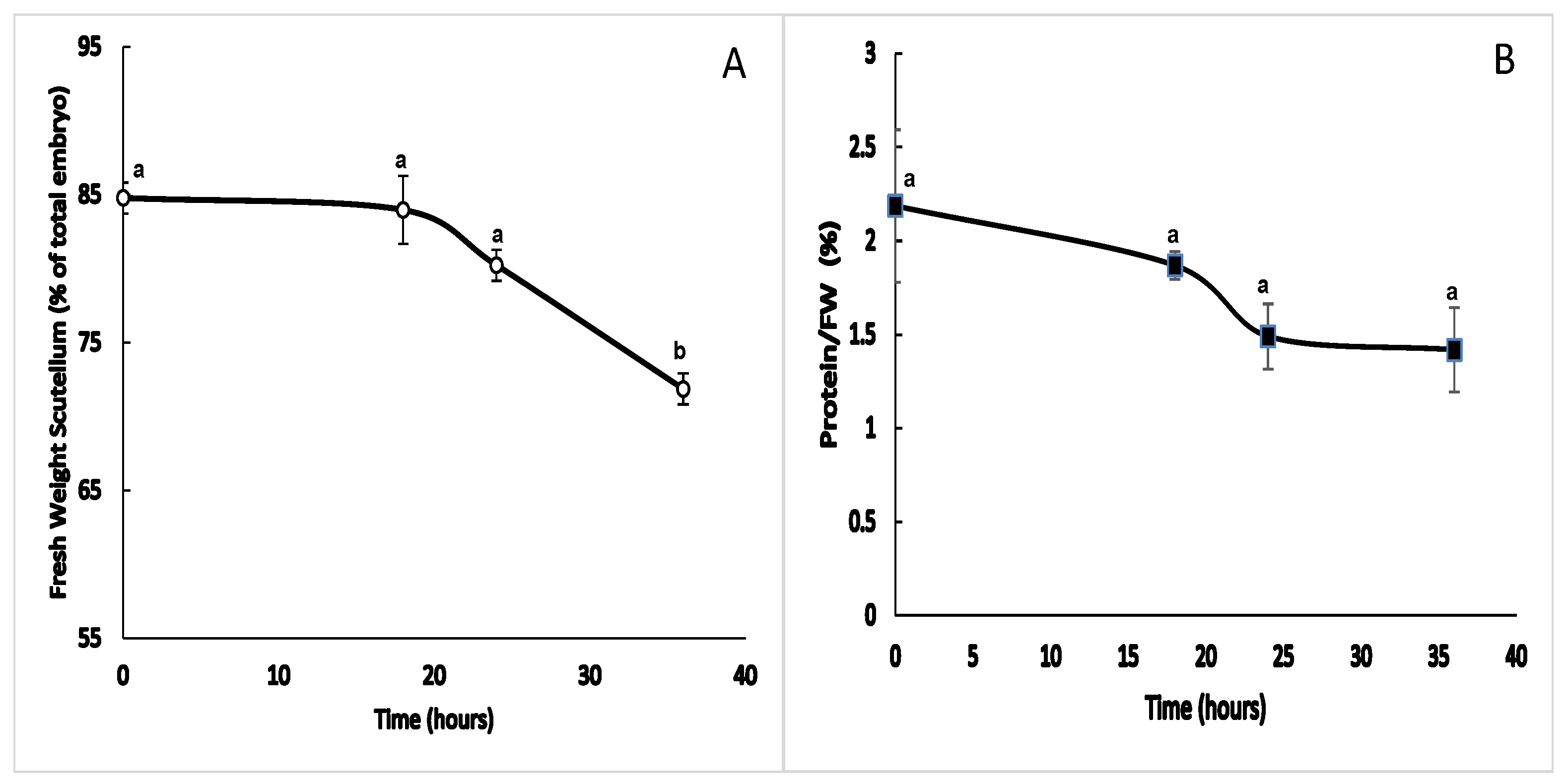
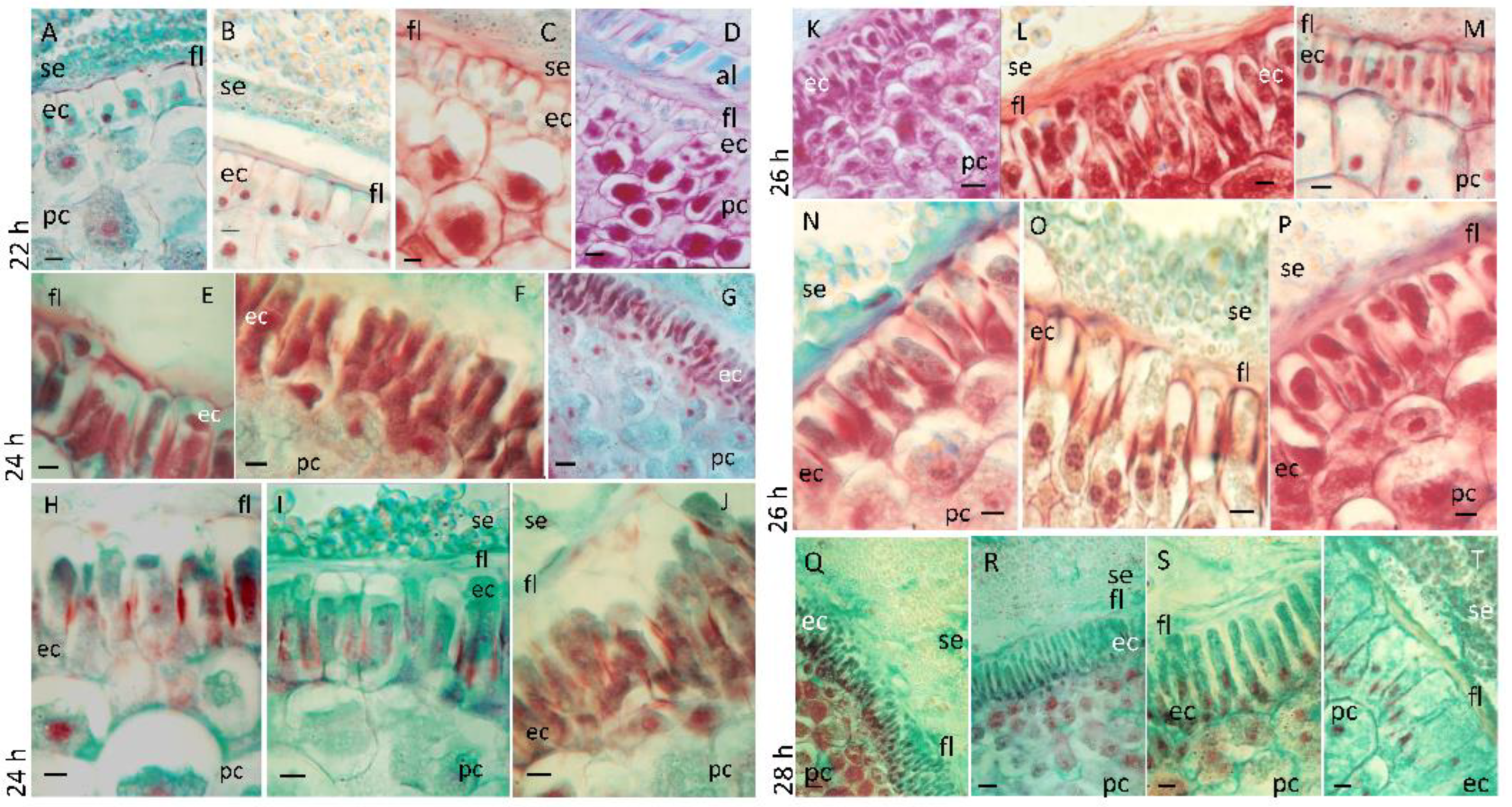
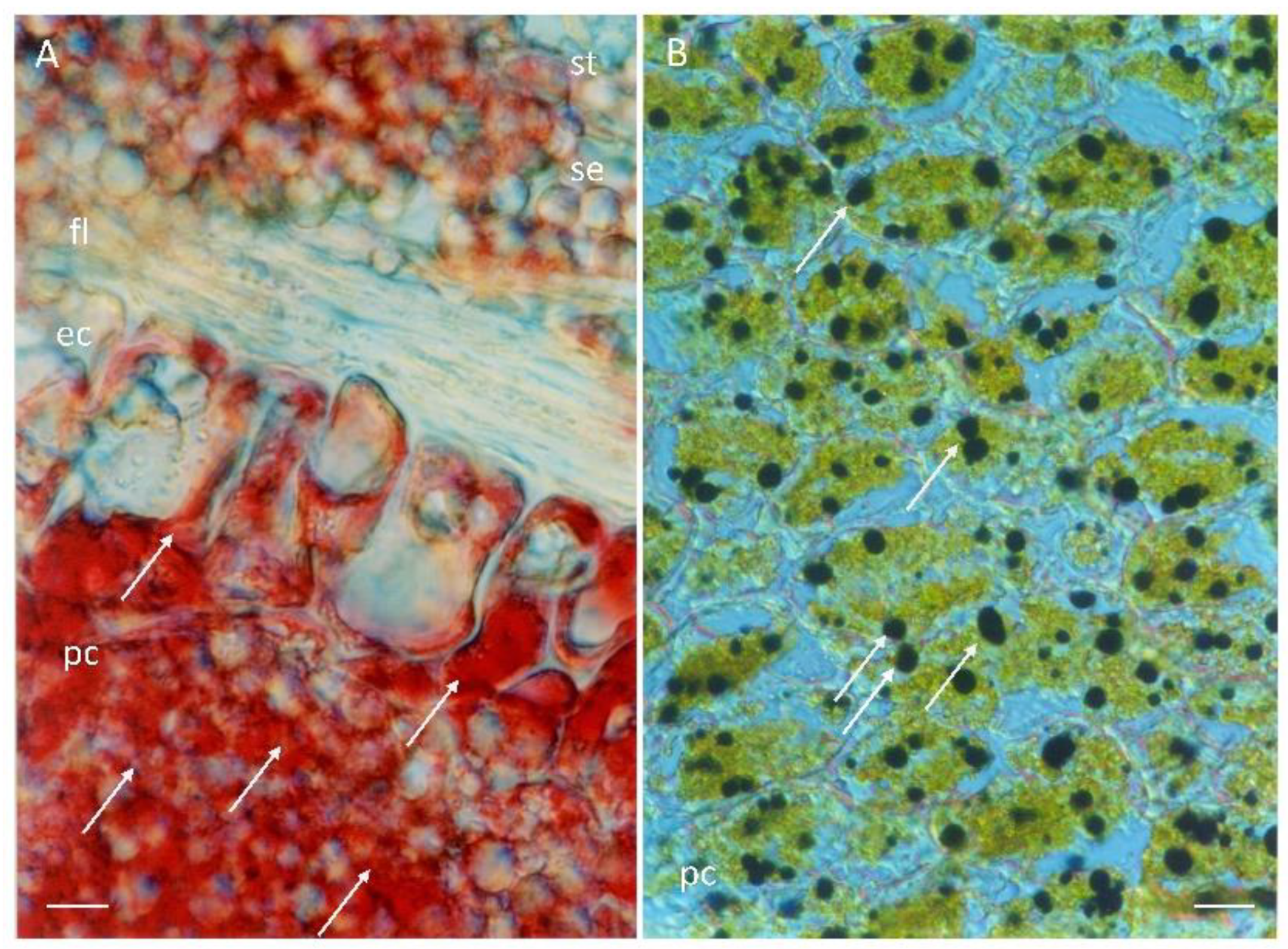
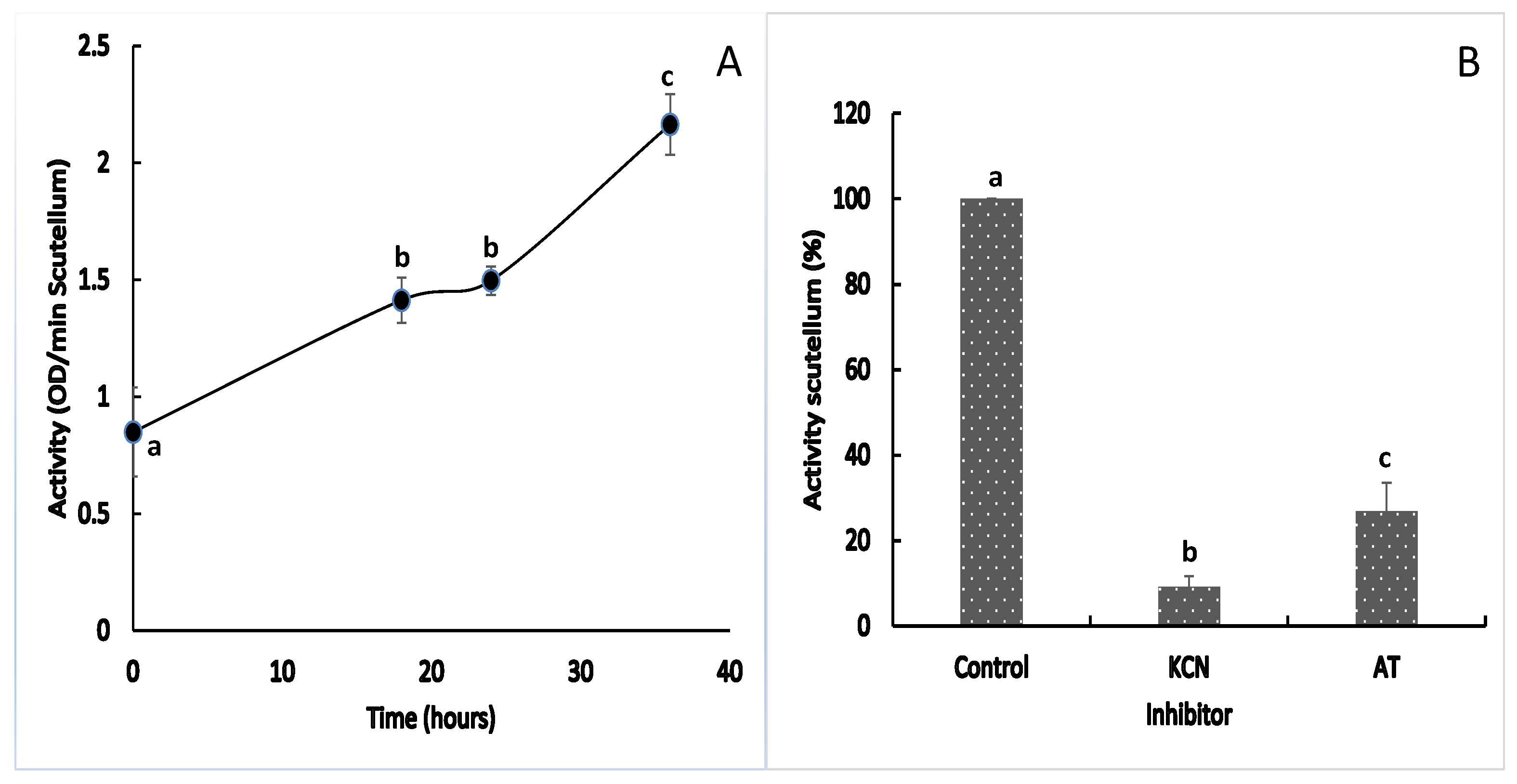
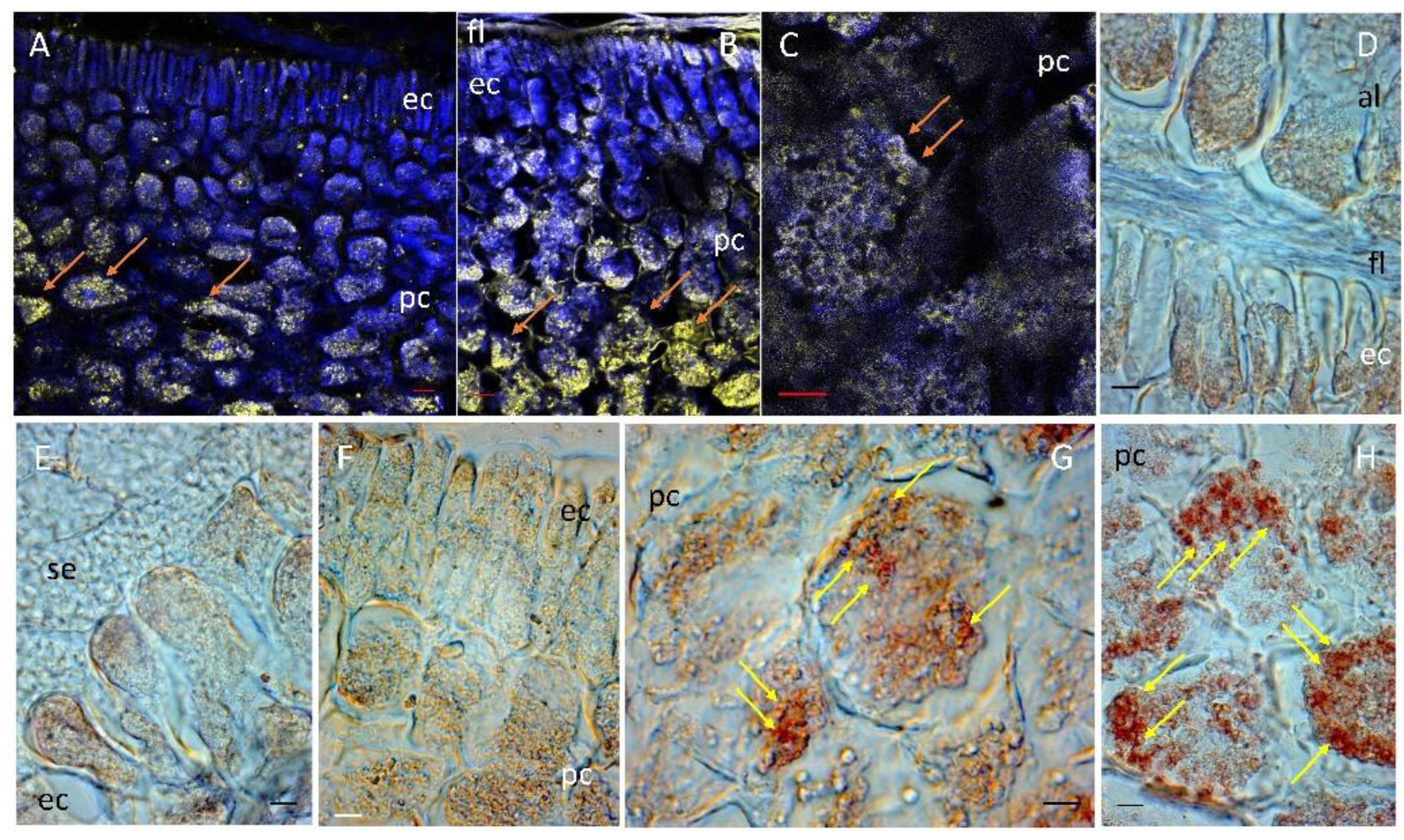
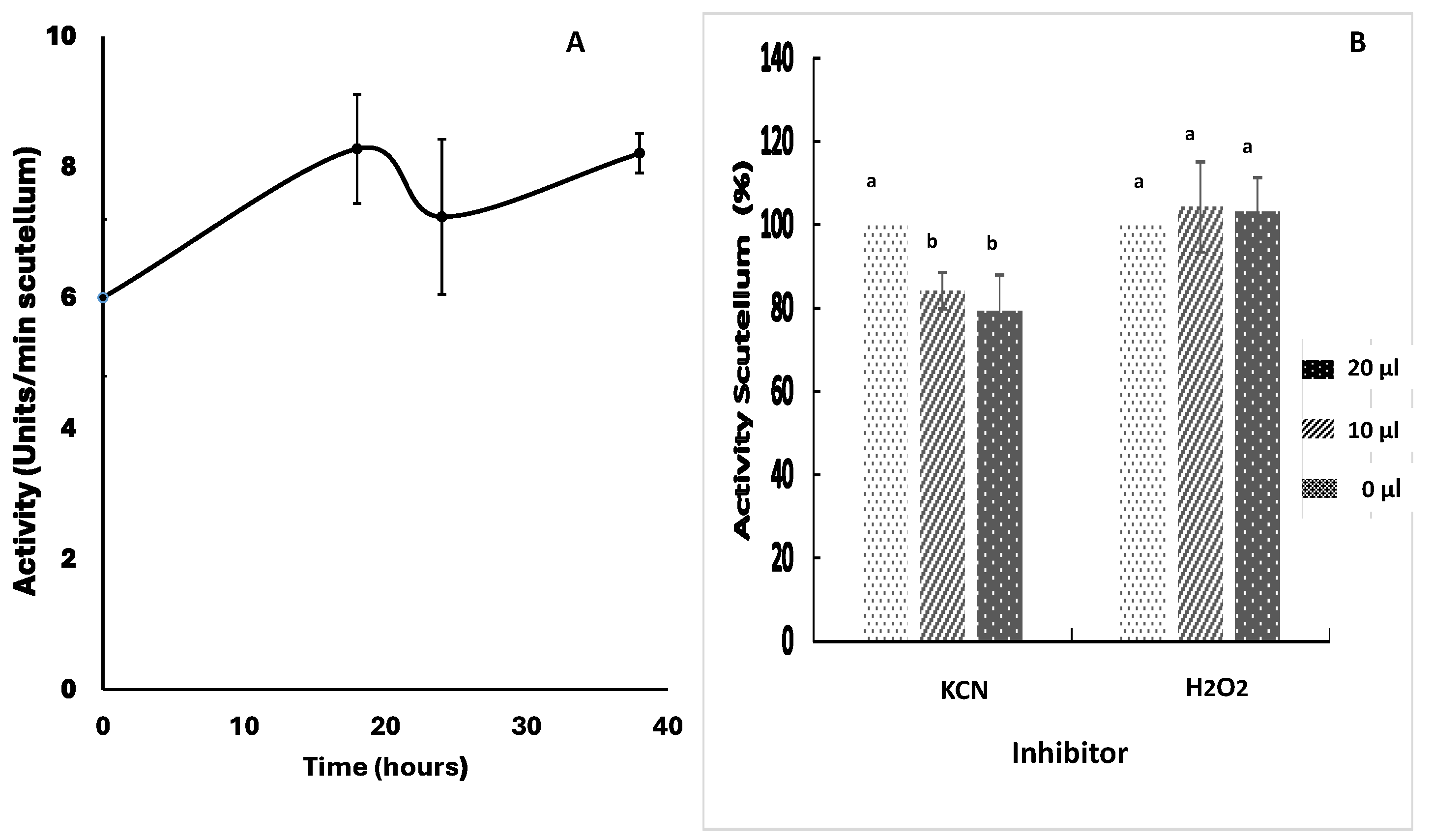
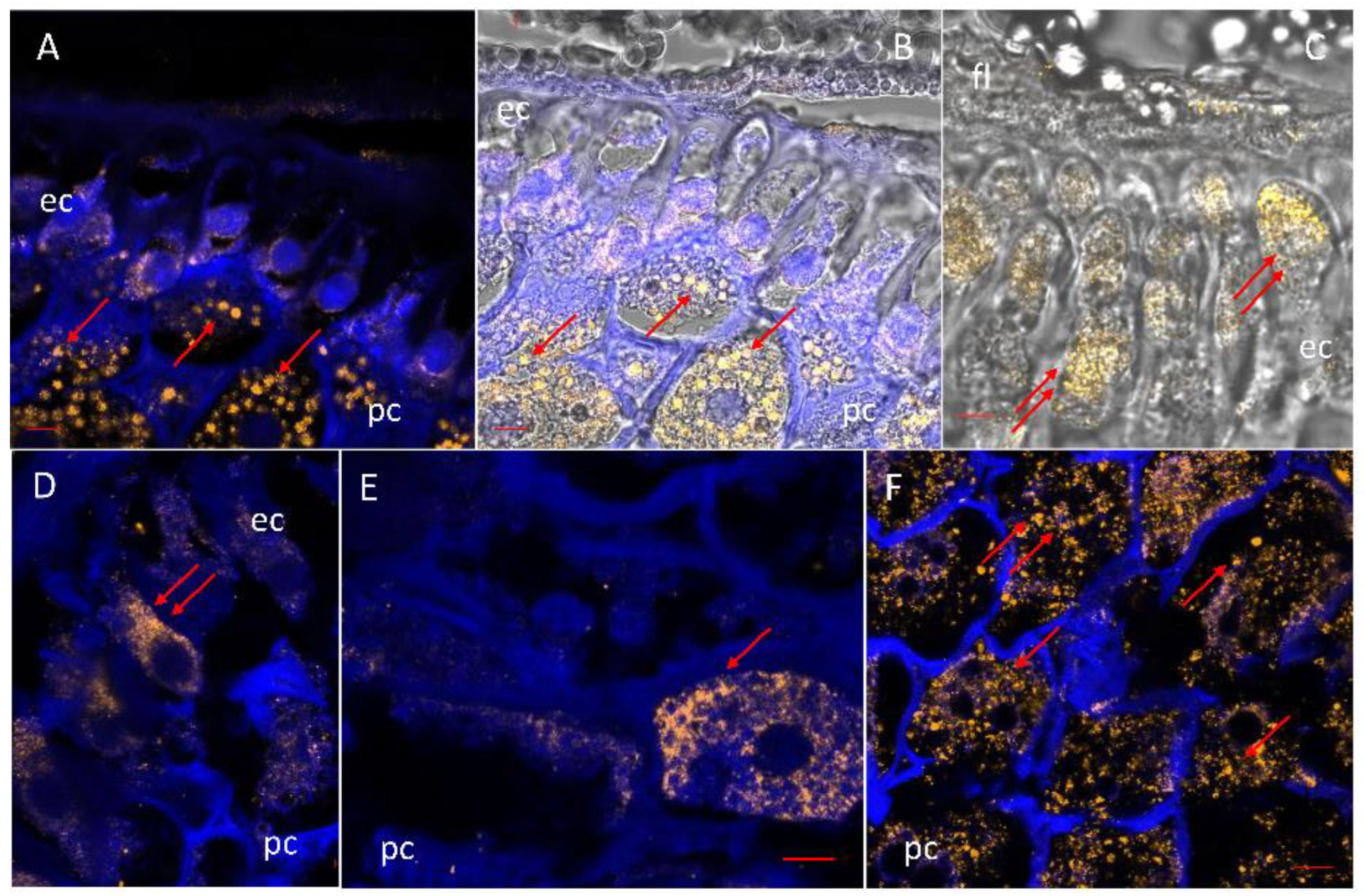

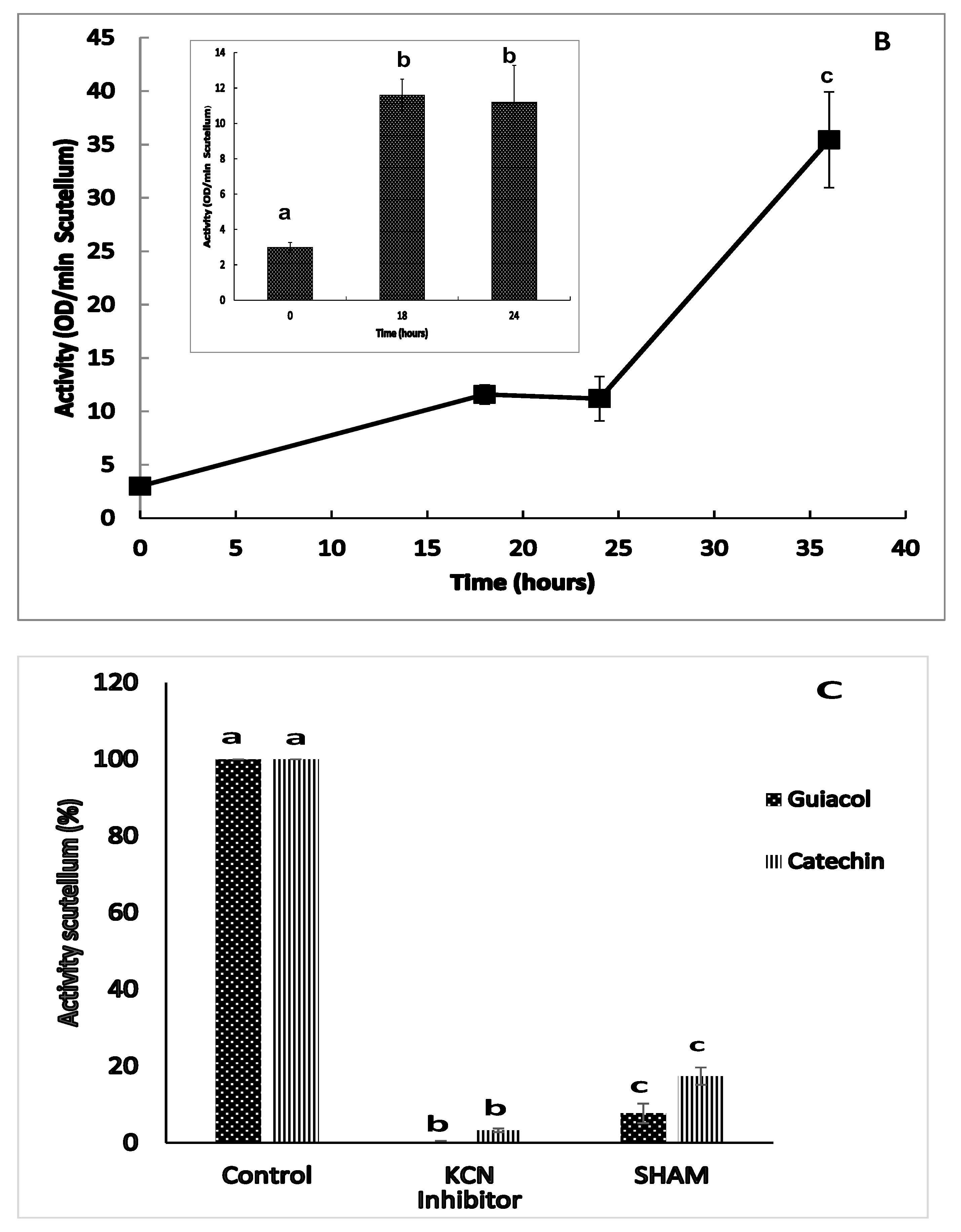
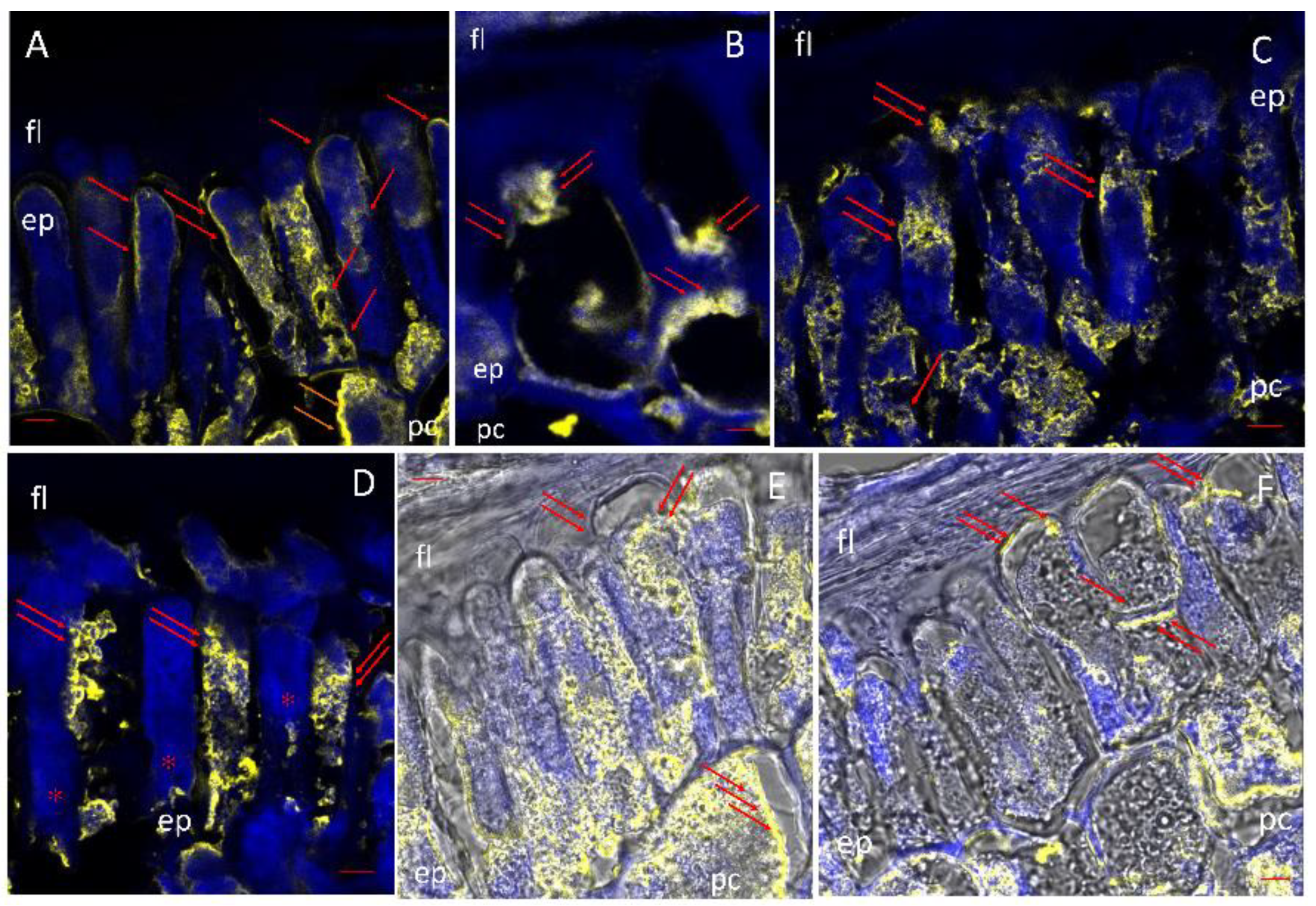
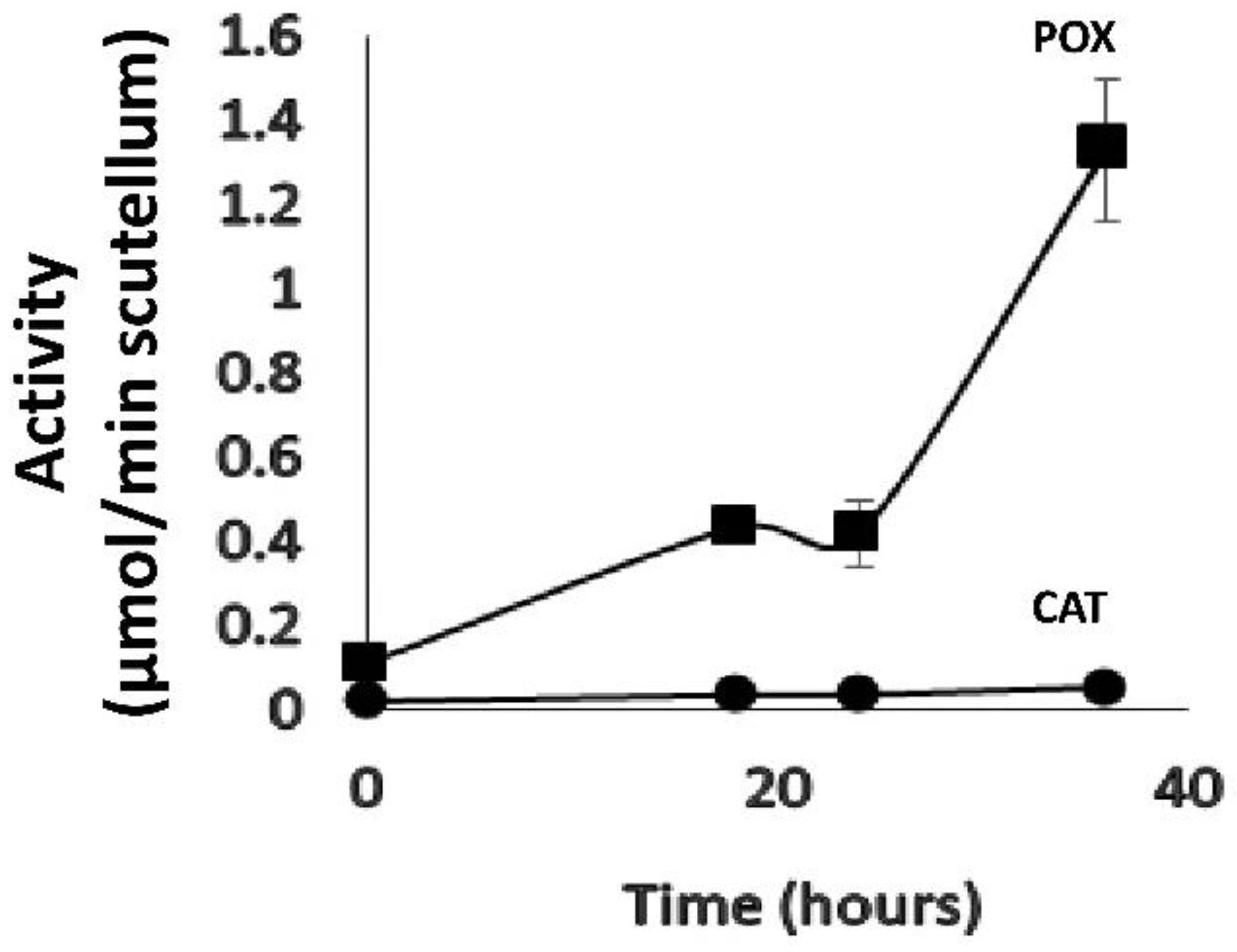
Disclaimer/Publisher’s Note: The statements, opinions and data contained in all publications are solely those of the individual author(s) and contributor(s) and not of MDPI and/or the editor(s). MDPI and/or the editor(s) disclaim responsibility for any injury to people or property resulting from any ideas, methods, instructions or products referred to in the content. |
© 2024 by the authors. Licensee MDPI, Basel, Switzerland. This article is an open access article distributed under the terms and conditions of the Creative Commons Attribution (CC BY) license (https://creativecommons.org/licenses/by/4.0/).
Share and Cite
Corona-Carrillo, J.I.; González, S.; Chávez Nájera, G.; Díaz-Pontones, D. Antioxidant System of Scutellum During Germination and Early Growth of Maize Seedlings. Agriculture 2024, 14, 2025. https://doi.org/10.3390/agriculture14112025
Corona-Carrillo JI, González S, Chávez Nájera G, Díaz-Pontones D. Antioxidant System of Scutellum During Germination and Early Growth of Maize Seedlings. Agriculture. 2024; 14(11):2025. https://doi.org/10.3390/agriculture14112025
Chicago/Turabian StyleCorona-Carrillo, José Isaac, Sandra González, Gerardo Chávez Nájera, and David Díaz-Pontones. 2024. "Antioxidant System of Scutellum During Germination and Early Growth of Maize Seedlings" Agriculture 14, no. 11: 2025. https://doi.org/10.3390/agriculture14112025
APA StyleCorona-Carrillo, J. I., González, S., Chávez Nájera, G., & Díaz-Pontones, D. (2024). Antioxidant System of Scutellum During Germination and Early Growth of Maize Seedlings. Agriculture, 14(11), 2025. https://doi.org/10.3390/agriculture14112025






